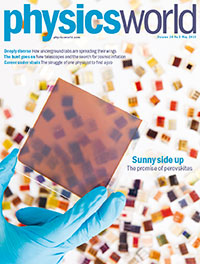By Matin Durrani
A couple of years back, I had the pleasure of travelling 1100 metres below ground to visit a dark-matter laboratory at the bottom of the Boulby Mine on the north-east coast of England. The journey was certainly memorable – it involved plunging down in a rattling lift cage for several minutes with a group of miners setting off on their morning shift. Once in the lab – housed inside a souped-up set of trailers – I interviewed physicist Sean Paling about the experimental projects going on there.
Setting up an underground lab, like that at Boulby, certainly doesn’t come cheap and in recent years, many have started to diversify into new areas. In the May issue of Physics World, which is now out in print and digital formats, Paling and his colleague Stephen Sadler – who is director at DURRIDGE UK Radon Instrumentation – describe the renaissance in the science taking place far beneath our feet. Studies in underground labs now range from Mars rovers to muon tomography and from radioactive dating to astrobiology.
If you’re a member of the Institute of Physics (IOP), you can get immediate access to the feature with the digital edition of the magazine on your desktop via MyIOP.org or on any iOS or Android smartphone or tablet via the Physics World app, available from the App Store and Google Play. If you’re not yet in the IOP, you can join as an IOPimember for just £15, €20 or $25 a year to get full digital access to Physics World.
 The issue also includes a great infographic detailing what’s going on at 10 underground labs around the world that are diversifying into new areas.
The issue also includes a great infographic detailing what’s going on at 10 underground labs around the world that are diversifying into new areas.
For the record, here’s a rundown of what else is in the issue.
• Max Planck boosts PhD support – Germany’s Max Planck Society is to put all its PhD students on contracts rather than grants, which will benefit overseas students in particular, as Michael Banks reports
• Setting the standard – Three decades on from winning the 1985 Nobel Prize for Physics for the discovery of the quantum Hall effect, Klaus von Klitzing talks to Michael Banks about the responsibility that comes with winning
• Cutting costs – Michael Kang argues that the high price of scientific equipment is choking science – especially in the developing world
• 15 years and counting – Robert P Crease reflects on a decade and a half of writing the
Critical Point column for Physics World
• Subterranean science – The deep underground laboratories of the world are no longer the scientific realm of astroparticle physics alone. From Mars rovers to muon tomography, and from radioactive dating to astrobiology, Sean Paling and Stephen Sadler describe the renaissance in the science taking place far beneath our feet
• Perovskites’ solar promise – Perovskite solar cells have quintupled in efficiency in the last five years, making them the fastest growing such type of device. But as Stephen Ornes explains, researchers have yet to overcome one final hurdle: figuring out how to stop them degrading in real-world applications
• After the cosmic dust settles – Last year’s reports that the BICEP2 telescope had uncovered evidence for cosmic inflation turned out to be a false alarm, but researchers in the field haven’t given up. Matthew R Francis describes how a new generation of telescopes is entering the hunt
• An interstellar culture clash – Jennifer Ouelette reviews The Three-Body Problem by Cixin Liu, translated by Ken Liu
• Latin America’s scientific ‘magic’ – Ronald Cintra Shellard reviews Beyond Imported Magic: Essays on Science, Technology, and Society in Latin America edited by Eden Medina, Ivan da Costa Marques and Christina Holmes
• Unemployed and STEM – Despite widely reported skills shortages in science, technology,
engineering and mathematics, some graduates in these disciplines are finding the job hunt anything but easy. Penny Jackson shares her experiences
• Once a physicist – Journalist Paul Danahar is the BBC’s Americas bureaux chief in Washington, DC. He was previously the BBC’s Middle East bureau chief between 2010 and 2013
• The most popular physics meme ever– In this month’s Lateral Thoughts, Sidney Perkowitz looks at what’s hot in physics
The underground laboratories with the lowest possible background are considered to be best place to look for very low probability phenomena such as the detection of neutrinos from different sources and their flavour fluctuation on the way, the double-beta decay to see, if neutrino is fermion or majorana in nature, search for the dark matter particle, even a place for the installation of appropriate accelerators to measure very small cross sections needed for astrophysics.